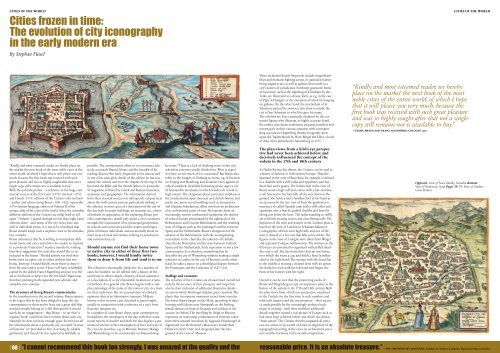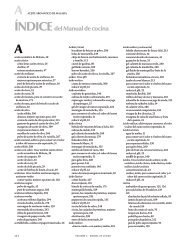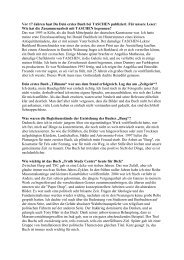“TASCHEN: wonderful publisher of sumptuous tomes.”
“TASCHEN: wonderful publisher of sumptuous tomes.”
“TASCHEN: wonderful publisher of sumptuous tomes.”
You also want an ePaper? Increase the reach of your titles
YUMPU automatically turns print PDFs into web optimized ePapers that Google loves.
CITIES OF THE WORLD<br />
Cities frozen in time:<br />
The evolution <strong>of</strong> city iconography<br />
in the early modern era<br />
By Stephan Füssel<br />
“Kindly and most esteemed reader, we hereby place on<br />
the market the next book <strong>of</strong> the most noble cities <strong>of</strong> the<br />
entire world, <strong>of</strong> which I hope that it will please you very<br />
much, because the first book was received with such<br />
great pleasure and was so highly sought-after that not a<br />
single copy still remains nor is available to buy.<strong>”</strong><br />
With this jubilant preface – a reference to the huge commercial<br />
success <strong>of</strong> the first Latin (1572), German (1574)<br />
and French (1575) editions <strong>of</strong> the Civitates orbis terrarum<br />
– author and editor Georg Braun (1541–1622) opens the<br />
1576 German-language edition <strong>of</strong> Volume II <strong>of</strong> his<br />
unique atlas <strong>of</strong> the cities <strong>of</strong> the world. Since the countless<br />
different editions <strong>of</strong> the Civitates are today hard to tell<br />
apart – Volume 1 passed through no less than eight Latin<br />
editions alone – and many <strong>of</strong> the city views were also<br />
sold as individual prints, it is not to be wondered that<br />
Braun should adopt such a euphoric tone in his introductory<br />
remarks.<br />
Braun announces that he is willing to incorporate additional<br />
towns and cities and invites his readers to respond<br />
in a positively “interactive<strong>”</strong> manner, namely by sending<br />
him their suggestions for cities they would like to see<br />
included in the future: “Should anyone not find their<br />
home town or native city in either <strong>of</strong> these first two<br />
books, however, I would kindly invite them to draw it<br />
from life and send it to me. Then I will have it faithfully<br />
copied by the skilled Franz Hogenberg and put it in the<br />
1st or 2nd book or keep it for the 3rd book.<strong>”</strong> Braun was<br />
therefore planning both expanded new editions and<br />
complete new volumes.<br />
The structure <strong>of</strong> Georg Braun’s commentaries<br />
In the introduction to the second volume, Braun expresses<br />
his regret that he has been obliged to keep the city<br />
commentaries so short and to leave out a great deal that<br />
would normally belong to “a full description<strong>”</strong>. It would<br />
surely be no exaggeration – thus Braun – to say that “a<br />
separate book<strong>”</strong> could have been written about each city.<br />
Naturally he does not have enough space for this, but all<br />
the information about a particular city recorded “in trusted<br />
histories<strong>”</strong> or “provided to him in writing by reliable<br />
gentlemen and friends<strong>”</strong> he has reported as faithfully as<br />
possible. The commentaries allow us to reconstruct relatively<br />
accurately Braun’s library and the breadth <strong>of</strong> his<br />
reading. Braun refers fairly frequently to his sources and<br />
in not a few cases gives details <strong>of</strong> the edition he has consulted,<br />
the volume and even the chapter. At the top <strong>of</strong> the<br />
list stand the Bible and the church fathers, in particular<br />
St Augustine, followed by Greek and Roman historians,<br />
statesmen and geographers. The information derived<br />
from these classical sources not infrequently eclipses facts<br />
about the 16th-century present; particularly striking is<br />
the absence, in most cases, <strong>of</strong> a description <strong>of</strong> the city <strong>of</strong><br />
the day, with its major buildings, art treasures etc., oriented<br />
towards its appearance in the engraving. Braun provides<br />
contemporary details only about a city’s economic<br />
strength, the constitution <strong>of</strong> its municipal government,<br />
its schools and universities and the names and biographies<br />
<strong>of</strong> famous individuals, and occasionally about its<br />
main areas <strong>of</strong> trade and matters relating to jurisdiction<br />
and customs duty, etc.<br />
Should anyone not find their home town<br />
or native city in either <strong>of</strong> these first two<br />
books, however, I would kindly invite<br />
them to draw it from life and send it to me<br />
The selection is thoroughly subjective. In a number <strong>of</strong><br />
cases, for example, we are <strong>of</strong>fered only a history <strong>of</strong> the<br />
university, in others simply a history <strong>of</strong> local commerce<br />
or a description <strong>of</strong> a city’s favourable location on a natural<br />
harbour. As a general rule, Braun begins with a complex<br />
etymology <strong>of</strong> the name <strong>of</strong> the town or city, in a manner<br />
that reads more like an accumulation <strong>of</strong> scholarly<br />
opinions than as an informative summary. Military<br />
history is also in some cases discussed at great length,<br />
usually in conjunction with a reference to a city’s fortifications,<br />
ramparts etc.<br />
In a number <strong>of</strong> cases Braun draws upon contemporary<br />
broadsheets, the newspapers <strong>of</strong> the day, with their sensational<br />
reports <strong>of</strong> murder and theft. He also displays a pronounced<br />
interest in the consumption <strong>of</strong> beer and wine in<br />
the cities he describes, e.g. in Münster, Bremen, Malaga<br />
and Weissenburg; in his commentary on Braunschweig<br />
he notes: “There is a lack <strong>of</strong> drinking water in this city,<br />
wherefore everyone usually drinks beer. Wine is expensive<br />
here, so not much <strong>of</strong> it is consumed.<strong>”</strong> But Braun also<br />
refers to the dangers <strong>of</strong> drinking to excess, e.g. in his texts<br />
on Leipzig and Hamburg, and measures cities against an<br />
ethical yardstick, invariably bestowing praise upon a city<br />
<strong>of</strong> honourable merchants in which handicraft is held in<br />
high esteem. The clergyman places particular emphasis in<br />
his commentaries upon diocesan and church history, and<br />
partly, too, upon sacred buildings such as monasteries<br />
and religious foundations, albeit not from an architectural<br />
or art-historical point <strong>of</strong> view. He laments, from an<br />
increasingly narrow confessional standpoint, the decline<br />
<strong>of</strong> central Europe precipitated by the upheavals <strong>of</strong> the<br />
Reformation and Counter-Reformation and the resulting<br />
wars <strong>of</strong> religion, such as the prolonged conflict between<br />
Spain and the Netherlands. Braun’s disapproval <strong>of</strong> the<br />
advance <strong>of</strong> the Reformation, with the accompanying<br />
iconoclasm in the churches, the takeover <strong>of</strong> Catholic<br />
churches by Protestants and the wars between Catholic<br />
Spain and the Netherlands, finds expression in not a few<br />
commentaries. It is therefore astonishing that he<br />
describes the city <strong>of</strong> Wittenberg without making a single<br />
reference to Luther. In the case <strong>of</strong> Bremen, on the other<br />
hand, he takes a stance on a theological dispute between<br />
the Protestants and the Lutherans <strong>of</strong> 1547–1563.<br />
Staffage and costumes<br />
The volumes <strong>of</strong> the Civitates are characterized overall not<br />
only by the accuracy <strong>of</strong> their prospects and maps, but<br />
also by their inclusion <strong>of</strong> additional illustrative details –<br />
an area in which Hoefnagel displays great creativity. The<br />
plates thus incorporate numerous scenes from everyday<br />
life: horse-drawn barges on the Main, quarrying <strong>of</strong> slate,<br />
hunting with falcons near Sárospatak on the Bodrog,<br />
female dancers in front <strong>of</strong> Granada and scholars in discussion<br />
in Oxford. The travelling by sleigh in Moscow<br />
represents an interesting combination <strong>of</strong> elements taken<br />
from three separate woodcuts by Augustin Hirschvogel in<br />
Sigismund von Herberstein’s Moscoviter wunderbare<br />
Historien (from 1546) and integrated into the foreground<br />
<strong>of</strong> the view <strong>of</strong> Moscow.<br />
These incidental details frequently include magnificent<br />
ships and dramatic fighting scenes, in particular battles<br />
being waged at sea, as well as gallows that testify to a<br />
city’s powers <strong>of</strong> jurisdiction. Extremely gruesome forms<br />
<strong>of</strong> execution, such as the impaling <strong>of</strong> Christians by the<br />
Turks, are illustrated in a drastic form, as e.g. in the case<br />
<strong>of</strong> Pápa in Hungary or the execution <strong>of</strong> rebels by hanging<br />
on gallows. On the other hand, the martyrdom <strong>of</strong> St<br />
Sebastian, pierced by arrows, is also shown outside the<br />
city <strong>of</strong> San Sebastián to which he gave his name.<br />
The volumes are lent a particular character by the costumed<br />
figures who illustrate, in highly accurate detail,<br />
the nobles, merchants, tradesmen, peasants, travellers and<br />
servant girls in their various costumes with corresponding<br />
accessories. Hogenberg thereby frequently drew<br />
upon the Trachtenbuch by Hans Weigel the Elder, a book<br />
<strong>of</strong> dress styles published in Nuremberg in 1577.<br />
The plan views from a bird’s-eye perspective<br />
had never been achieved before and<br />
decisively influenced the concept <strong>of</strong> the<br />
vedutà in the 17th and 18th century<br />
As Nadin Kirsten has shown, the Civitates can be read as<br />
a history <strong>of</strong> fashion in 16th-century Europe. Thus the<br />
Spaniard in the view <strong>of</strong> Barcelona, for example, is dressed<br />
in a doublet with a stiff collar and epaulettes, and has<br />
short hair and a goatee. The Italian lady in the view <strong>of</strong><br />
Rome wears a high ruff and a dress with a low neckline;<br />
a veil fastened to her hair falls all the way down to the<br />
ground. She holds a fancy handkerchief in her hand as<br />
an accessory. In the city view <strong>of</strong> Paris the gentleman is<br />
wearing a so-called Spanish cape with a stiff collar and<br />
epaulettes over a heavily padded doublet and hose finishing<br />
just below the knee. The ladies standing so stiffly<br />
are evidently wearing corsets and close-fitting ruffs. The<br />
depiction <strong>of</strong> the men and women in the London plate is<br />
based on the view <strong>of</strong> London in Sebastian Münster’s<br />
Cosmographia: all four wear high ruffs, and one <strong>of</strong> the<br />
men is dressed in a fur coat that falls to his ankles. The<br />
figures in the view <strong>of</strong> Cologne were taken from Weigel<br />
and represent Cologne noblewomen. The woman on the<br />
left wears an unwaisted overgarment with puffed shoulders<br />
and a ruff. She has twisted her hair up into horns,<br />
over which she wears a cap, and holds a fancy handkerchief<br />
in her right hand. The woman with the broad hat<br />
in the middle is wearing a waisted dress with an apron;<br />
she holds her train with her left hand and fingers the<br />
brim <strong>of</strong> her bonnet with her right.<br />
Overall it can be seen that the pioneering works <strong>of</strong><br />
Braun and Hogenberg occupy an impressive place in the<br />
history <strong>of</strong> the vedutà in the 17th and 18th century. Both<br />
the plan views from a bird’s-eye perspective, employed<br />
in the Civitates for the first time in such numbers and<br />
with such mastery, and the city prospects – their accuracy<br />
made possible by the increasingly perfected technique<br />
<strong>of</strong> etching – with their wealth <strong>of</strong> additional<br />
details, together created a real picture <strong>of</strong> Europe such as<br />
had never been achieved before and which was drawn<br />
“from nature<strong>”</strong>. The Civitates thereby surpassed all previous<br />
city atlases in its wealth <strong>of</strong> detail, its depiction <strong>of</strong> the<br />
topographical setting <strong>of</strong> the cities, its architectural precision<br />
and the harmony <strong>of</strong> the overall composition.<br />
“Kindly and most esteemed reader, we hereby<br />
place on the market the next book <strong>of</strong> the most<br />
noble cities <strong>of</strong> the entire world, <strong>of</strong> which I hope<br />
that it will please you very much, because the<br />
first book was received with such great pleasure<br />
and was so highly sought-after that not a single<br />
copy still remains nor is available to buy.<strong>”</strong><br />
—GEORG BRAUN AND FRANZ HOGENBERG, COLOGNE 1576<br />
CITIES OF THE WORLD<br />
Opposite: View <strong>of</strong> Nové Zámky, Slovakia Bottom:<br />
View <strong>of</strong> Damascus, Syria Pages 70–71: View <strong>of</strong> London,<br />
Great Britain<br />
| 68 | “I cannot recommend this book too strongly. I was amazed at the quality and the reasonable price. It is an absolute treasure.<strong>”</strong> —THE OBSERVATORY MAGAZINE, London, on Andreas Cellarius. Harmonia Macrocosmica






